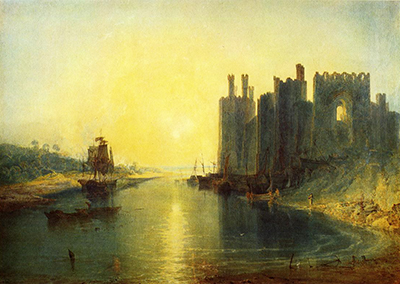Artist Turner produced a number of depictions of Caernarvon Castle in the very late 18th century. The one found here is perhaps the most famous of the entire series.
This painting shows the clear influence of French Luminist, Claude Lorrain. It is specifically the way in which the sunshine beams across the rippling water, placed centrally between two banks that remind us of the work of the 17th century master. The composition captures Caernarvon Castle on the right hand side, with the banks circling around the bottom of the picture, with the sea lapping against the shore. To the left is a simpler amount of content so as not to draw attention from the main focal point of the painting. A number of ships can be seen to the left in order to add a sense of activity, but this is predominantly a relaxed artwork, where man and nature are seen in relative harmony.
That balance compares with some of his dramatic scenes out at sea, where ships could be eaten alive by strong winds, huge waves or even snow storms. In truth, there is a love within the art public for both of these approaches, and Turner is seen as someone who really took the landscape and seascape genres into as many avenues as possible, both in style and also medium. He produced a number of watercolours alongside his oil paintings, plus hundreds of study drawings too. There were also engraved prints produced from some of his raw sketchwork that helped in promoting his reputation into new social circles that would not have been able to afford to purchase his original pieces. That approach was also used by Hogarth and Stubbs to help strengthen their careers and financial standing.
The artist travelled to North Wales on a number of occasions in the late 18th century, and each time would spend more time there. He loved the Snowdonian landscape and also would seek out the major castles of this region. The rolling hills allowed him to try out different viewpoints, some of which would herald such a variety of content that one would not immediately recognise them of being of the same castle. He would also, naturally, try out different conditions within his work such as powerful storms or, as seen here, a much more tranquil scenario. He found a beauty in nature which he felt obliged to explore throughout his career.




